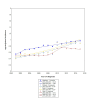Incidence of Gastrointestinal Stromal Tumors in the United States from 2001-2015: A United States Cancer Statistics Analysis of 50 States
- PMID: 31037234
- PMCID: PMC6478492
- DOI: 10.7759/cureus.4120
Incidence of Gastrointestinal Stromal Tumors in the United States from 2001-2015: A United States Cancer Statistics Analysis of 50 States
Abstract
Introduction Gastrointestinal stromal tumor (GIST) was once a mislabeled cancer with inaccurate incidence data in the United States (US). Since the discovery of a gain of function mutation in kit, the proper identification of GIST has greatly improved. Given this inaccuracy in prior GIST incidence, our goal in this study was to evaluate the true incidence of GIST in at-risk populations in all 50 states. Methods The United States Cancer Statistics (USCS) was used to obtain data for GISTs from 2001 to 2015. Incidence analysis was done for sex, race, stage, primary location, and US regional location. Results The overall incidence of GISTs from 2001-2015 was 0.70 per 100,000 people per year. Overall incidence rates were greatest for each stratification of males, blacks, localized disease, primary location in the stomach, and the Northeast. The incidence in blacks increased with an annual percent change (APC) of 6.27 between 2001 and 2015. Between 2001 and 2015, the incidence of localized disease and GISTs with a primary location in the stomach increased with APCs of 8.90 and 6.25, respectively. In the Northeast, between 2001 and 2003, the incidence initially increased expeditiously (APC 13.35); however, after 2003, the incidence continued to rise but no longer at the same rapid rate (APC 3.05). Conclusion In our study, we investigated the incidence of GISTs using data from the USCS database for all 50 states in the US. We found an alarming rise in the incidence in blacks, localized disease, the stomach, and those in the Northeast. Ultimately, further studies are required to identify risk factors for the development of GISTs; however, our study will serve as a template to help guide those studies.
Keywords: cancer; epidemiology; gastroenterology; gastrointestinal stromal tumor; gist; incidence.
Conflict of interest statement
The authors have declared that no competing interests exist.
Figures





References
-
- Gastric stromal tumors. Reappraisal of histogenesis. Mazur MT, Clark HB. https://www.ncbi.nlm.nih.gov/pubmed/6625048. Am J Surg Pathol. 1983;7:507–519. - PubMed
-
- Gain-of-function mutations of c-kit in human gastrointestinal stromal tumors. Hirota S, Isozaki K, Moriyama Y, et al. https://www.ncbi.nlm.nih.gov/pubmed/9438854. Science. 1998;279:577–580. - PubMed
-
- National Cancer Institute, DCCPS, Surveillance Research Program; [Feb;2019 ]. 2019. Surveillance, epidemiology, and end results (SEER) program.
LinkOut - more resources
Full Text Sources
Miscellaneous
